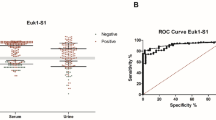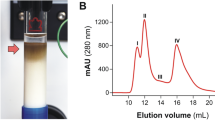Abstract
ACCUMULATING evidence suggests an aetiological relationship between Australia (Au/SH)-antigen and serum hepatitis1–5. So far this antigen has been demonstrated in the serum of diseased and apparently healthy persons only. It has been shown that serum hepatitis can be transmitted orally in humans6,7, so that the demonstration of this antigen in excretions (urine, faeces, sputum and so on) might be of great epidemiological interest. Because the antigen is likely to be highly diluted in these materials, we concentrated the urine by affinity adsorption chromatography8,9. About 500 ml. of urine adjusted to pH 7.2 was put through a column of ‘Sepharose 4 B’ (1.0 × 5.0 cm), which was charged with an Au/SH-antigen antiserum (20 mg of protein/ml. of ‘Sepharose’, flow rate, 50 ml./h). After the column had been washed with about 50 ml. of 0.15 M phosphate buffer, pH 7.2, the bound antigen was eluted by using 0.15 M glycine-HCl buffer, pH 1.8. The eluate of about 10 ml. was further concentrated by vacuum ultrafiltration to a final volume of about 0.2 ml., and subjected to immunoelectrophoresis10. We had checked the sensitivity of the method by diluting 0.1 ml. of serum containing Australia antigen with 500 ml. of water, and confirmed that we could isolate the antigen again. We routinely test sera of patients with suspected liver disease for the presence of Au/SH antigen by immunoelectrophoresis, and the urine of positive cases is further investigated according to the method we have described.
This is a preview of subscription content, access via your institution
Access options
Subscribe to this journal
Receive 51 print issues and online access
$199.00 per year
only $3.90 per issue
Buy this article
- Purchase on Springer Link
- Instant access to full article PDF
Prices may be subject to local taxes which are calculated during checkout
Similar content being viewed by others
References
Blumberg, B. S., Arch. Intern. Med., 125, 287 (1970).
Prince, A. M., Proc. US Nat. Acad. Sci., 60, 814 (1968).
Prince, A. M., Lancet, ii, 462 (1968).
Shulman, N. R., and Barker, L. F., Science, 165, 304 (1969).
Zuckerman, A. J., Nature, 223, 569 (1969).
Giles, J. P., McCollum, R. W., Berndson, jun., L. W., and Krugman, S., New. Engl. J. Med., 281, 119 (1969).
Krugman, S., Giles, J. P., and Hammond, J., J. Amer. Med. Assoc., 200, 365 (1967).
Axén, R., Porath, J., and Ernback, S., Nature, 214, 1302 (1967).
Porath, J., Axén, R., and Ernback, S., Nature, 215, 1491 (1967).
Krassnitzky, O., Pesendorfer, F., and Wewalka, F., Dtsch. Med. Wschr., 95, 249 (1970).
Lancet, ii, 989 (1969).
J. Amer. Med. Assoc., 200, 406 (1967).
Jones, P. O., Goldsmith, H. J., Wright, F. K., Roberts, C., and Watson, D. C., Lancet, i, 835 (1967).
Author information
Authors and Affiliations
Rights and permissions
About this article
Cite this article
TRIPATZIS, I., HORST, H. Detection of Australia-SH-Antigen in Urine. Nature 231, 266–267 (1971). https://doi.org/10.1038/231266a0
Received:
Issue Date:
DOI: https://doi.org/10.1038/231266a0
This article is cited by
-
Renal morphological and immunological changes associated with acute viral hepatitis
Kidney International (1972)
Comments
By submitting a comment you agree to abide by our Terms and Community Guidelines. If you find something abusive or that does not comply with our terms or guidelines please flag it as inappropriate.



